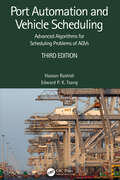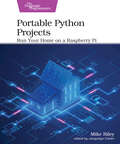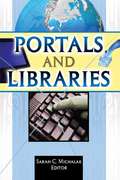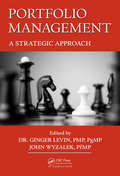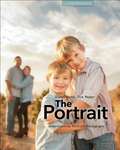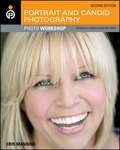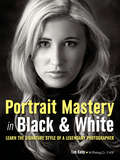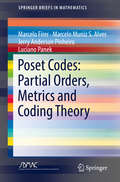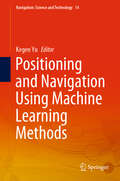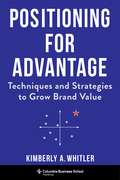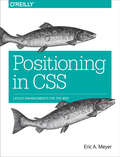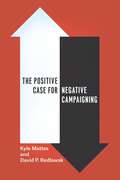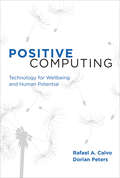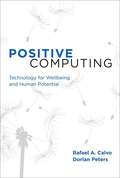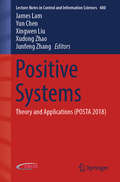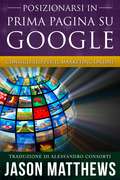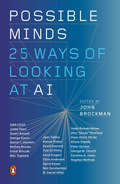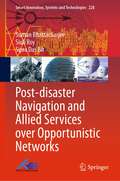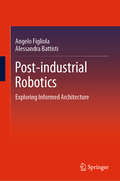- Table View
- List View
Port Automation and Vehicle Scheduling: Advanced Algorithms for Scheduling Problems of AGVs
by Hassan Rashidi Edward P. TsangContainer terminals are constantly being challenged to adjust their throughput capacity to match fluctuating demand. Examining the optimization problems encountered in today’s container terminals, Port Automation and Vehicle Scheduling: Advanced Algorithms for Scheduling Problems of AGVs, Third Edition provides advanced algorithms for handling the scheduling of Automated Guided Vehicles (AGVs) in ports. Building on the earlier editions, previously titled Vehicle Scheduling in Port Automation: Advanced Algorithms for Minimum Cost Flow Problems, this book has undergone extensive revisions and includes two new chapters. New material addresses the solutions to the modeling of decisions in Chapter 3, while in Chapter 11 the authors address an emerging challenge in automated container terminals with integrated management. Key Features: ◾Classifies the optimization problems of the ports into five scheduling decisions. For each decision, it supplies an overview, formulates each of the decisions as constraint satisfaction and optimization problems, and then covers possible solutions, implementation, and performance. ◾Explores in Part One of the book the various optimization problems in modern container terminals, while details in Part Two advanced algorithms for the minimum cost flow (MCF) problem and for the scheduling problem of AGVs in ports. ◾Offers complete package that can help readers address the scheduling problems of AGVs in ports. This is a valuable reference for port authorities and researchers, including specialists and graduate students in operation research. For specialists, it provides novel and efficient algorithms for network flow problems. For students, it supplies the most comprehensive survey of the field along with a rigorous formulation of the problems in port automation.
Portable Python Projects: Run Your Home On A Raspberry Pi
by Mike RileyDiscover easy ways to control your home with the powerful new Raspberry Pi hardware. Program short Python scripts that will detect changes in your home and react with the instructions you code. Use new add-on accessories to monitor a variety of measurements, from light intensity and temperature to motion detection and water leakage. Expand the base projects with your own custom additions to perfectly match your own home setup. Most projects in the book can be completed in under an hour, giving you more time to enjoy and tweak your autonomous creations. No breadboard or electronics knowledge required! Get to know the latest Raspberry Pi hardware, and create awesome automation solutions for home or work that don't require an electronics degree, cumbersome add-ons, or expensive third-party subscription services. Create easy to run Python scripts on your own that make your Pi do things that would have required a team of automation experts to build only a few years ago. Connect to and control popular home automation lighting systems from a Raspberry Pi. Trigger autonomous actions based on movement, temperature, and timer events. Power on your own computer and appliances using your voice. Remotely control infrared-enabled consumer electronics, create chatbots to retrieve personalized items of interest, and implement a temperature-monitoring room fan. These are just some of the projects that the book will show you how to make. Most projects can be completed and operational in under an hour, and do not require any messy schematics or a spaghetti bowl of wires and breadboard-attached circuits to operate. Control your home or office exactly the way you want instead of relying on an expensive mysterious box of third-party technology to do it for you. What You Need: Raspberry Pi (Pi 4 Model B or higher recommended) running Raspberry Pi OS
Portals and Libraries
by Sarah C. MichalakCutting-edge information about providing access to research library usersThe ultimate goal of librarians is to provide comprehensive informational access to library users. Portals and Libraries provides an in-depth look at various libraries&’ challenges and the cutting-edge technology used in providing high-quality electronic access to users through portal systems. Respected authorities detail efforts to build a new kind of search and retrieval system that includes access to the Web as well as other vital collections and academic resources. The book discusses the implementation of access systems and their supporting technology, and spotlights strategies designed to encourage quality system-user feedback, increase the cooperation and diligence of staff, and more. Portals and Libraries comprehensively reviews library portals from their roots to their current state, with a look at assorted products, their implementation issues, and each one&’s advantages and shortcomings. The overall state of the portal system today as well as where it is heading in the future is examined in detail. The book also provides the ARL Scholars Portal Working Group Final Report from May 2002 summarizing the group&’s work from its inception, and includes their recommendations of key portal features and needed functions. The text includes helpful screenshots, useful descriptive figures, and extensive references.Portals and Libraries discusses: the history of library portals the MyLibrary@NCState Web portal after five years of use "Portals to the World" Library of Congress guide to Web resources the role integrated library systems will play in the future of portals features and services to be added to library portals for greater success portal technologies-their structures and functioning planning portal implementation online catalogs usability testing and interface design nine key issues that will impact the future of portal developmentPortals and Libraries is crucial reading for library educators and students, college and research librarians in reference, library system professionals, and technical services professionals focused on applying cutting-edge technology to library services.
Portfolio Management: A Strategic Approach (Best Practices In Portfolio, Program, And Project Management Ser. #17)
by Ginger Levin; John WyzalekRecognizing the importance of selecting and pursuing programs, projects, and operational work that add sustainable business value that benefits end users, the Project Management Institute (PMI) issued its first Standard on Portfolio Management in 2006. In 2014, it launched the Portfolio Management Professional (PfMP) credential-which several of the
Portlets in Action
by Ashish SarinSummaryPortlets in Action is a comprehensive, hands-on guide to building portlet-driven applications in Java. Covers Portlet 2.0, Spring 3.0 Portlet MVC, WSRP 2.0, Portlet Bridges, Ajax, Comet, Liferay, GateIn, Spring JDBC, and Hibernate. About the TechnologyPortlets are the small Java applications that run within a portal. Good portlets work independently and also communicate fluently with the portal, other portlets, as well as outside servers and information sources. Using Java's Portlet 2.0 API and portal servers like Liferay, you can build flexible, stable business portals without the design overhead required by other application styles.About the BookPortlets in Action is a comprehensive guide to building portlet-driven applications in Java. It teaches portlet development hands-on as you develop a portal that incorporates most key features of the Portlet 2.0 API. And because portals and portlets are so flexible, the accompanying source code can be easily adapted and reused. Along the way, you'll learn how to work with key web frameworks like Spring 3.0 Portlet MVC and DWR.Written for Java developers. No prior experience with portlets required Purchase of the print book comes with an offer of a free PDF, ePub, and Kindle eBook from Manning. Also available is all code from the book. What's InsideComplete coverage of the Portlet 2.0 APISpring 3.0 Portlet MVC and the Liferay portal serverPortal design best practicesReusable source code================================Table of ContentsPART 1 GETTING STARTED WITH PORTLET DEVELOPMENTIntroducing portals and portletsThe portlet lifecyclePortlet 2.0 API - portlet objects and container-runtime optionsPortlet 2.0 API - caching, security, and localizationBuilding your own portalUsing the portlet tag libraryPART 2 DEVELOPING PORTLETS USING SPRING AND HIBERNATEGetting started with Spring Portlet MVCAnnotation-driven development with SpringIntegrating portlets with databasesPART 3 ADVANCED PORTLET DEVELOPMENTPersonalizing portletsCommunicating with other portletsAjaxing portletsReusable logic with portlet filtersPortlet bridgesWeb Services for Remote Portlets (WSRP)
The Portrait
by Glenn Rand Tim MeyerGlenn Rand, longtime photographic educator and Program Director for Graduate Programs at Brooks Institute, and Tim Meyer, Portrait Division Chair at Brooks Institute, have collaborated to create a thorough and balanced textbook on the modern techniques and practice of portrait photography. They have avoided the single-style viewpoint common to so many books on portraiture and have crafted a definitive resource for professionals, as well as students and avid amateurs, wishing to advance their skills in this discipline. Topics include: Quality of light and the portrait Ambient, continuous, and strobe light sources Understanding light modifiers and enhancers Mastering lighting ratios Importance and selection of backgrounds Extensive coverage of lighting setups Understanding light meters and metering in portraiture Lighting patterns on the human face Facial analysis Composition in portraiture Eliciting the appropriate expression The fine art portrait Portraiture for the masses
Portrait and Candid Photography Photo Workshop
by Erin ManningThe secret to taking great "people pictures" is to observe your subjects, connect with them, and use your camera to its best advantage. Here's how to work with lighting, location, angle, composition, physical characteristics, environment, and countless other variables, including the unique challenges of photographing babies, group activities, and action. Learn to capture facial expressions, tell a story with a series of candids, add interest to large-group shots, and more. Apply these techniques and watch your subjects come to life.
Portrait Mastery in Black & White
by Tim KellyTim Kelly is a Master Photographer whose portrait work has inspired people in the portrait photography industry since the 1980s. His work has a classic, polished quality that beautifully depicts the personality of each subject, with no gimmicks. His style is reliant on careful camera technique, flawless lighting, and an uncanny ability to coax the most flattering-possible pose from every man, woman, and child who steps in front of his camera.In this book, Tim Kelly presents 60 of his most impressive and diverse black & white portrait images of men, women, children, and groups. For each of the sixty images, readers will get a deconstructive look at every aspect of building the image, from the ground up. Kelly will discuss the creative concept behind his images and share the gear, exposure, lighting, and posing strategies he learned to create gorgeous black & white portraiture with an exquisite tonal range, beautiful, form-flattering highlights and shadows, and both refined and comfortable poses that invite the viewer to study the image frame.This book contains all of the information you need to create standout black & white portraiture-from conceptualization, to posing and lighting, to postproduction and printing options.
Portrait Pro
by Jeff SmithDroves of hobbyist photographers make a move to professional photography every year. They read a few books, watch rock star photographers shoot online, make business cards, and forge their path to a new career. When they book clients, work through the session, proof their images, and conduct a sales session, though, they encounter artistic, organizational, and financial problems they had not anticipated, and many stall out.In this book, Jeff Smith focuses on finding an audience and a target demographic, honing your posing and lighting skills, working with clients, and managing business and personnel concerns.Smith begins by taking a close look at the mind-set required for forging ahead as a professional photographer. He shows you how to define and target the clientele you want to work with and teaches you skillful approaches for creating and maintaining a strong photographer-client relationship. He notes that many photographers enter the business to create images that please them and explains that to be successful, photographers must instead learn to gain insight into just what the client wants to see in the final photos in order to maximize profits and keep clients coming back for more.With a clearly defined objective and approach outlines, Smith moves on to tackle common technical issues that new pros find daunting. He provides tips for creating perfect lighting in the studio and outdoors. He also discusses positioning for every part of the body, to create an ideal presentation to the camera. Next, he provides compositional tips-from where to position the subject in the frame, to selecting the best camera angle, to cropping for impact-in order to maximize image impact and present the best-possible image to your client.Finally, with the technical and artistic fields addressed, Smith turns to a discussion on the business side of the profession. He offers advice on acquiring equipment, understanding costs and pricing, creating new business opportunities, identifying an ideal studio location, and even managing your time.
Poset Codes: Partial Orders, Metrics and Coding Theory (SpringerBriefs in Mathematics)
by Marcelo Firer Marcelo Muniz S. Alves Jerry Anderson Pinheiro Luciano PanekThis book offers an organized and systematic approach to poset metrics and codes. Poset metrics, or metrics on a vector field determined by a partial order over a finite set, were first introduced in the mid-1990s by the mathematicians Richard A. Brualdi, Janine S. Graves and K. Mark Lawrence, and to date the relevant knowledge on this subject was spread over more than two hundred research papers. Poset metrics generalizes both the standard Hamming metric – the most important metric used in the context of coding theory – and the Niederreiter-Rosenbloom-Tsfasman metric, which is an ultrametric. Conceived to be as self-contained as possible, the book starts from basic concepts of coding theory and advances towards coding theory for poset metrics and generalizations. Each chapter includes a survey of the topic presented and a list of exercises, drawn in part from recently proven results. This work will appeal to researchers and graduate students alike, particularly those in the fields of Mathematics, Electrical Engineering and Computer Sciences, with an interest in discrete geometry and coding theory.
Posicionando Conteúdo no Google em 3 Passos
by Álvaro CidTenho comparado este método com minha forma de fazer as coisas antes e depois e tenho rankeado muito mais alto, atraindo muito mais visitas a meu site web. E graças a este método, tenho poupando tempo, esforço e energia. Ao padronizar tudo, posso me concentrar mais no meu leitor. Muitas pessoas gostariam de ser capazes de posicionar-se no Google com sua página de web ou blog. O problema, é que realmente não sabem como fazer. Inclusive algumas pessoas têm tentado posicionar-se com alguns artigos ou conteúdo, mas sem nenhum resultado. Esse é o momento em que os amadores abandonam. Infelizmente, nenhum deles nunca conseguiram posicionar um artigo corretamente. Este manual irá de ajudar a posicionar os seus conteúdos no menor tempo possível e seguindo as melhores práticas do Google. Tenho desenvolvido este método com base nas minhas experiências nos meus conhecimentos e em resultados que tenho obtido. Este método foi desenvolvido para qualquer um, com ou sem experiência, para que possa posicionar seus conteúdos de maneira correta alcançando uma boa posição o mais rápido possível. Os passos a seguir seram rápidos e intuitivos, qualquer um pode seguir e se o seguem estaram em melhor posição que a concorrência em termos de conteúdo dos seu posicionamentos: *Você terá um método efetivo e replicável em cada um de seus conteúdos. *Você conseguirá analizar as tendências e se posicionar frente a concorrência. *Você melhorará seu conteúdo a os olhos do Google e especialmente para seus leitores *Você terá um aumento em sua marca pessoal e seu posicionamento online. *Este último irá permitir o ganho de possivéis relacionamentos de trabalho e oportunidades de negócios
Positioning and Navigation Using Machine Learning Methods (Navigation: Science and Technology #14)
by Kegen YuThis is the first book completely dedicated to positioning and navigation using machine learning methods. It deals with ground, aerial, and space positioning and navigation for pedestrians, vehicles, UAVs, and LEO satellites. Most of the major machine learning methods are utilized, including supervised learning, unsupervised learning, deep learning, and reinforcement learning. The book presents both fundamentals and in-depth studies as well as practical examples in positioning and navigation. Extensive data processing and experimental results are provided in the major chapters through conducting experimental campaigns or using in-situ measurements.
Positioning for Advantage: Techniques and Strategies to Grow Brand Value
by Professor Kimberly A. WhitlerMost of us have an intuitive sense of superior branding. We prefer to purchase brands we find distinctive—that deliver on some important, relevant dimension better than other brands. These brands have typically achieved positional advantage. Yet few professionals have had the formal training that goes beyond marketing theory to bridge the “theory-doing gap”—understanding the specific techniques and strategies that can be used to create brands that attain positional advantage in the marketplace.Positioning for Advantage is a comprehensive how-to guide for creating, building, and executing effective brand strategies. Kimberly A. Whitler identifies essential marketing strategy techniques and moves through the major stages of positioning a brand to achieve in-market advantage. Introducing seven tools—from strategic positioning concepts to strategy mapping to influencer maps—Whitler provides templates, frameworks, and step-by-step processes to build and manage growth brands that achieve positional advantage. This book presents real-world scenarios, helping readers activate tools to increase skill in creating brands that achieve positional advantage. Brimming with insights for students and professionals alike, Positioning for Advantage helps aspiring C-level leaders understand not only what superior branding looks like but also how to make it come to life.
Positioning in CSS: Layout Enhancements for the Web
by Eric A. MeyerThe Grid Layout spec will soon change your approach to website design, but there will still be plenty of uses for CSS positioning tricks. Whether you want to create sidebars that remain in the viewport (browser window), add sticky section headings to lists or long articles, or overlap one element with another, this concise ebook will expertly guide you through all the main CSS positioning types.Short and deep, this book is an excerpt from the upcoming fourth edition of CSS: The Definitive Guide. When you purchase either the print or the ebook edition of Positioning in CSS, you’ll receive a discount on the entire Definitive Guide once it’s released. Why wait? Make your web pages come alive today.You'll learn how to:Remove an element from a document but keep its new position part of the document’s flow with absolute positioningKeep an element like a masthead or sidebar in one fixed position in the viewport with fixed positioningPreserve an element’s shape and the space it occupied in the document with relative positioningMake a document’s headers selectively stay still in response to scrolling conditions with sticky positioningEric A. Meyer is an author, speaker, blogger, sometime teacher, and co-founder of An Event Apart. He’s a two-decade veteran of the Web and web standards, a past member of the W3C’s Cascading Style Sheets Working Group, and the author of O’Reilly’s CSS: The Definitive Guide.
The Positive Case for Negative Campaigning
by Kyle Mattes David P. RedlawskTurn on the television or sign in to social media during election season and chances are you’ll see plenty of negative campaigning. For decades, conventional wisdom has held that Americans hate negativity in political advertising, and some have even argued that its pervasiveness in recent seasons has helped to drive down voter turnout. Arguing against this commonly held view, Kyle Mattes and David P. Redlawsk show not only that some negativity is accepted by voters as part of the political process, but that negative advertising is necessary to convey valuable information that would not otherwise be revealed. The most comprehensive treatment of negative campaigning to date, The Positive Case for Negative Campaigning uses models, surveys, and experiments to show that much of the seeming dislike of negative campaigning can be explained by the way survey questions have been worded. By failing to distinguish between baseless and credible attacks, surveys fail to capture differences in voters’ receptivity. Voters’ responses, the authors argue, vary greatly and can be better explained by the content and believability of the ads than by whether the ads are negative. Mattes and Redlawsk continue on to establish how voters make use of negative information and why it is necessary. Many voters are politically naïve and unlikely to make inferences about candidates’ positions or traits, so the ability of candidates to go on the attack and focus explicitly on information that would not otherwise be available is crucial to voter education.
Positive Computing: Technology for Wellbeing and Human Potential
by Rafael A. Calvo Dorian PetersA case for building a digital environment that can make us happier and healthier, not just more productive, and a theoretical framework for doing so.On the eve of Google's IPO in 2004, Larry Page and Sergey Brin vowed not to be evil. Today, a growing number of technologists would go further, trying to ensure that their work actively improves people's lives. Technology, so pervasive and ubiquitous, has the capacity to increase stress and suffering; but it also has the less-heralded potential to improve the well-being of individuals, society, and the planet. In this book, Rafael Calvo and Dorian Peters investigate what they term “positive computing”—the design and development of technology to support psychological well-being and human potential. Calvo and Peters explain that technologists' growing interest in social good is part of a larger public concern about how our digital experience affects our emotions and our quality of life—which itself reflects an emerging focus on humanistic values in many different disciplines. Synthesizing theory, knowledge, and empirical methodologies from a variety of fields, they offer a rigorous and coherent foundational framework for positive computing. Sidebars by experts from psychology, neuroscience, human–computer interaction, and other disciplines supply essential context. Calvo and Peters examine specific well-being factors, including positive emotions, self-awareness, mindfulness, empathy, and compassion, and explore how technology can support these factors. Finally, they offer suggestions for future research and funding.SidebarsTimothy N. Bickmore, Jeremy Bailenson, danah boyd, Jane Burns, David R. Caruso, Mihaly Csikszentmihalyi, Felicia Huppert, Mary-Helen Immordino-Yang, Adele Krusche and J. Mark G. Williams, Jane McGonigal, Jonathan Nicholas, Don Norman, Yvonne Rogers
Positive Computing
by Dorian Peters Rafael A. CalvoOn the eve of Google's IPO in 2004, Larry Page and Sergey Brin vowed not to be evil. Today, a growing number of technologists would go further, trying to ensure that their work actively improves people's lives. Technology, so pervasive and ubiquitous, has the capacity to increase stress and suffering; but it also has the less-heralded potential to improve the well-being of individuals, society, and the planet. In this book, Rafael Calvo and Dorian Peters investigate what they term "positive computing" -- the design and development of technology to support psychological well-being and human potential. Calvo and Peters explain that technologists' growing interest in social good is part of a larger public concern about how our digital experience affects our emotions and our quality of life -- which itself reflects an emerging focus on humanistic values in many different disciplines. Synthesizing theory, knowledge, and empirical methodologies from a variety of fields, they offer a rigorous and coherent foundational framework for positive computing. Sidebars by experts from psychology, neuroscience, human--computer interaction, and other disciplines supply essential context. Calvo and Peters examine specific well-being factors, including positive emotions, self-awareness, mindfulness, empathy, and compassion, and explore how technology can support these factors. Finally, they offer suggestions for future research and funding.SidebarsTimothy N. Bickmore, Jeremy Bailenson, danah boyd, Jane Burns, David R. Caruso, Mihaly Csikszentmihalyi, Felicia Huppert, Mary-Helen Immordino-Yang, Adele Krusche and J. Mark G. Williams, Jane McGonigal, Jonathan Nicholas, Don Norman, Yvonne Rogers
Positive Systems: Theory and Applications (POSTA 2018) (Lecture Notes in Control and Information Sciences #480)
by James Lam Yun Chen Xingwen Liu Xudong Zhao Junfeng ZhangThis book presents high-quality original contributions on positive systems, including those with positivity in compartmental switched systems, Markovian jump systems, Boolean networks, interval observer design, fault detection, and delay systems. It comprises a selection of the best papers from POSTA 2018, the 6th International Conference on Positive Systems, which was held in Hangzhou, China, in August 2018. The POSTA conference series represents a targeted response to the growing need for research that reports on and critically discusses a wide range of topics concerning the theory and applications of positive systems. The book offers valuable insights for researchers in applied mathematics, control theory and their applications.
Posizionarsi in Prima Pagina su Google - Consigli SEO per il Marketing Online
by Jason Matthews Alessandro ConsortiArrivare in prima pagina su Google tramite facili suggerimenti SEO. Semplicemente tramite il SEO (search engine optimization) si può far arrivare qualsiasi sito in cima, senza spendere soldi. Scoprite nuovi modi di usare le parole chiave, i meta description ed i tag, categorie/etichette, titoli, costruzione di link ed altro. Istruzioni dettagliate per aiutare il vostro sito a raggiungere la prima pagina di Google. Tutti possono farcela. Non costa nulla a parte un po' di tempo. Scoprirete: *le migliori parole chiave, sia di tipo short-tail che long-tail *meta tag con meta description nel sorgente della pagina *modi di ottimizzare testo ed immagini *collegamenti URL di ritorno verso altri siti *come monitorare le tendenze dei visitatori *piattaforme online e come incrementare la visibilità *strumenti per il social media (Google Plus, Facebook, Twitter, ecc.) *come collegarsi con persone di tutto il mondo *molto altro... In un periodo che va da poche settimane a qualche mese, vedrete risultati reali ed arriverete in prima pagina. Argomenti trattati: SEO, suggerimenti SEO, Google, Google AdWords, ottimizzazione dei motori di ricerca, marketing online, business online, internet marketing, internet business, e-commerce, e-business, parole chiave, keyword planner, ricerca delle parole chiave, blog, blogging, AdWords, Bing
Possibility Theory for the Design of Information Fusion Systems (Information Fusion and Data Science)
by Basel Solaiman Éloi BosséThis practical guidebook describes the basic concepts, the mathematical developments, and the engineering methodologies for exploiting possibility theory for the computer-based design of an information fusion system where the goal is decision support for industries in smart ICT (information and communications technologies). This exploitation of possibility theory improves upon probability theory, complements Dempster-Shafer theory, and fills an important gap in this era of Big Data and Internet of Things.The book discusses fundamental possibilistic concepts: distribution, necessity measure, possibility measure, joint distribution, conditioning, distances, similarity measures, possibilistic decisions, fuzzy sets, fuzzy measures and integrals, and finally, the interrelated theories of uncertainty..uncertainty. These topics form an essential tour of the mathematical tools needed for the latter chapters of the book. These chapters present applications related to decision-making and pattern recognition schemes, and finally, a concluding chapter on the use of possibility theory in the overall challenging design of an information fusion system. This book will appeal to researchers and professionals in the field of information fusion and analytics, information and knowledge processing, smart ICT, and decision support systems.
Possible Minds: Twenty-Five Ways of Looking at AI
by John BrockmanScience world luminary John Brockman assembles twenty-five of the most important scientific minds, people who have been thinking about the field artificial intelligence for most of their careers, for an unparalleled round-table examination about mind, thinking, intelligence and what it means to be human."Artificial intelligence is today's story--the story behind all other stories. It is the Second Coming and the Apocalypse at the same time: Good AI versus evil AI." --John BrockmanMore than sixty years ago, mathematician-philosopher Norbert Wiener published a book on the place of machines in society that ended with a warning: "we shall never receive the right answers to our questions unless we ask the right questions.... The hour is very late, and the choice of good and evil knocks at our door." In the wake of advances in unsupervised, self-improving machine learning, a small but influential community of thinkers is considering Wiener's words again. In Possible Minds, John Brockman gathers their disparate visions of where AI might be taking us.The fruit of the long history of Brockman's profound engagement with the most important scientific minds who have been thinking about AI--from Alison Gopnik and David Deutsch to Frank Wilczek and Stephen Wolfram--Possible Minds is an ideal introduction to the landscape of crucial issues AI presents. The collision between opposing perspectives is salutary and exhilarating; some of these figures, such as computer scientist Stuart Russell, Skype co-founder Jaan Tallinn, and physicist Max Tegmark, are deeply concerned with the threat of AI, including the existential one, while others, notably robotics entrepreneur Rodney Brooks, philosopher Daniel Dennett, and bestselling author Steven Pinker, have a very different view. Serious, searching and authoritative, Possible Minds lays out the intellectual landscape of one of the most important topics of our time.
Post-disaster Navigation and Allied Services over Opportunistic Networks (Smart Innovation, Systems and Technologies #228)
by Suman Bhattacharjee Siuli Roy Sipra Das BitThis book provides the details of developing a digital pedestrian map construction system over the intermittently connected mobile network. Over the past couple of decades, countries across the world, both developing and developed, have witnessed a significant number of disasters. Thus, it has become mandatory for each of the disaster-prone countries to equip themselves with appropriate measures to cope with the challenges of providing post-disaster services. Some of the serious challenges are incapacitated communication infrastructure, unstable power supply and inaccessible road networks. Out of these challenges, the destruction of road networks, especially in developing countries, acts as a major hindrance to effective disaster management. To be more specific, the success of a disaster response operation generally depends on the speed of evacuation and transportation of adequate amount of relief materials at the right time to the disaster-affected areas. Hence, map-based navigation support is a primary requirement for post-disaster relief operations. This book also provides the solution of the two other important post-disaster management services such as situational awareness and resource allocation. Both of these services are invariably dependent on the existence of navigation support. Finally, in order to offer such services, the other challenge is to address the problem of incapacitated communication infrastructure. This book also deals with such challenges in post-disaster scenarios and develops automated post-disaster management services.
Post-Human Futures: Human Enhancement, Artificial Intelligence and Social Theory (The Future of the Human)
by Mark CarriganThis volume engages with post-humanist and transhumanist approaches to present an original exploration of the question of how humankind will fare in the face of artificial intelligence. With emerging technologies now widely assumed to be calling into question assumptions about human beings and their place within the world, and computational innovations of machine learning leading some to claim we are coming ever closer to the long-sought artificial general intelligence, it defends humanity with the argument that technological ‘advances’ introduced artificially into some humans do not annul their fundamental human qualities. Against the challenge presented by the possibility that advanced artificial intelligence will be fully capable of original thinking, creative self-development and moral judgement and therefore have claims to legal rights, the authors advance a form of ‘essentialism’ that justifies providing a ‘decent minimum life’ for all persons. As such, while the future of the human is in question, the authors show how dispensing with either the category itself or the underlying reality is a less plausible solution than is often assumed.
Post-Human Institutions and Organizations: Confronting the Matrix (The Future of the Human)
by Ismael Al-Amoudi; Emmanuel LazegaWhen the Matrix trilogy was published in the mid-1980s, it introduced to mass culture a number of post-human tropes about the conscious machines that have haunted our collective imaginaries ever since. This volume explores the social representations and significance of technological developments – especially AI and human enhancement – that have started to transform our human agency. It uses these developments to revisit theories of the human mind and its essential characteristics: a first-person perspective, concerns and reflexivity. It looks at how the smart machines are used as agents of change in the basic institutions and organisations that hold contemporary societies together, for example in the family and the household, in commercial corporations, in health institutions or in the military. Its main purpose is to enrich the ongoing public discussion of the social and political implications of the smart machines by looking at the extent to which they further digitalise and bureaucratise the world, in particular by asking whether they are used to develop techno-totalitarian societies that corrode normativity and solidarity.
Post-industrial Robotics: Exploring Informed Architecture (Springerbriefs In Architectural Design And Technology Ser.)
by Angelo Figliola Alessandra BattistiThis book highlights the concept of informed architecture as an alternative to performance-based approaches. Starting with an analysis of the state of art, the book defines an operative methodology in which performative parameters lead to the generation of the shape becoming the design’s input, rather than being mere quantitative parameters. It then uses case studies to investigate the methodology. Lastly, the book discusses a novel way of conceiving and using the manufacturing tool, which is the basis for the definition of informed architectures in relation to data usage and the optimization process.
